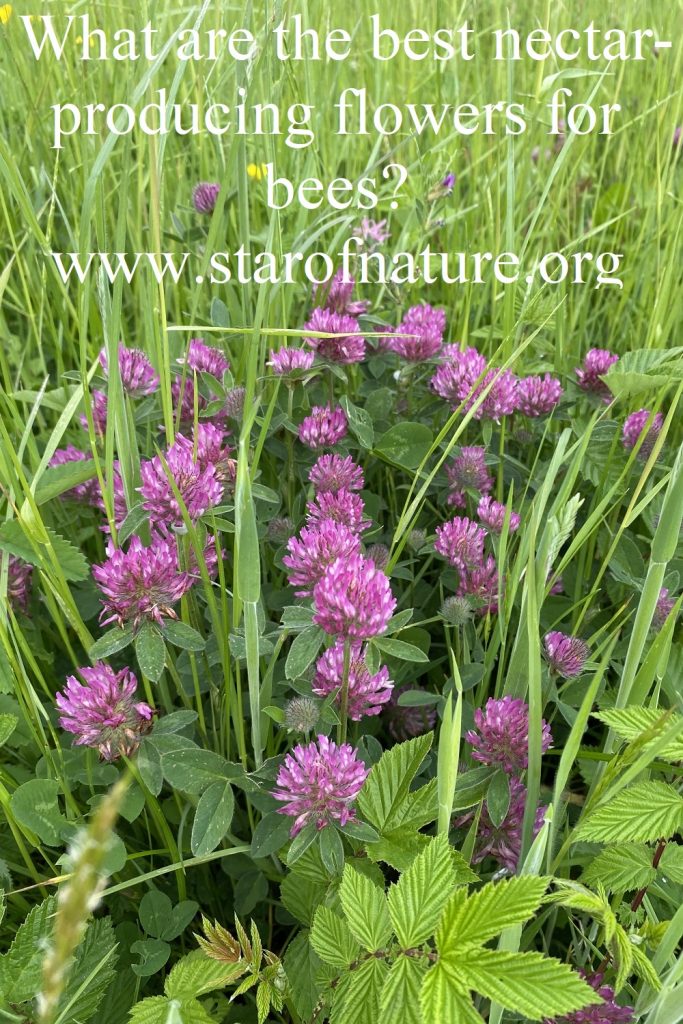What are the Best Nectar-Producing Flowers for Bees?
What flowers produce the largest quantities of nectar? Flowers rich in nectar provide food for pollinators, such as honeybees, bumble bees, moths and butterflies. Since pollinators are in decline due to the destruction of their habitats and the use of chemicals in agriculture, we need to help them by growing the right plants.
Nectar and pollen as food for insects
Plants rely on insects for their fertility. Though some are pollinated by wind, many need insects to spread their pollen. Some plants are capable of self-pollination, but cross-pollination, when pollen is carried from the flowers of one plant to the flowers of another plant, is better.
Numerous studies, starting with those by Charles Darwin, have demonstrated that cross-pollination results in better fruit, better seeds and better progeny that grows from these seeds.
Insects therefore perform a very important service for plants. And plants have developed ways to attract and reward them. Plants produce nectar, a sweet substance that is collected and eaten by insects, including bees, flies, wasps, butterflies and moths.
Insects also eat pollen. Whereas nectar provides them with water and sugars, pollen is a source of protein and fats. If we want insects to survive, pollinate our crops and make honey, we need to ensure that there is enough food for them throughout the season when they are active.
Best nectar-producing flowers for bees and other pollinators
So what flowers produce the largest quantities of nectar? Which should be grown by beekeepers, perhaps on a large scale? Which should be grown by all of us, who want to help bees, in our gardens, on our balconies and window boxes?
Using observation and experiments, scientists have calculated how much nectar, approximately, different plants produce. Of course, nectar production is very variable, dependent on the weather and conditions in which plants grow. The figures, however, even though very approximate, are interesting.
The figures below are in kilos of nectar, collected by bees during the entire season, per hectare of land planted with a flower. A hectare equals about 2.47 acres or 10,000 m2.
A list of nectar-rich flowers graded by productivity
17 kg/ha
Bird’s-foot trefoil (Lotus corniculatus). Fairly common, easy to grow and a very attractive wild flower. Self-sows readily, immune to pests and diseases. Not easily crashed and can grow on lawns and fields were animals graze.
10-20 kg/ha
Apple, cherry and plum trees. Fruit trees flower early in spring and are much visited by bees at an important time when colonies grow. Honey collected from fruit-trees does not set for a long time and is good for overwintering bees.
Blackberry (Morus nigra). Flowers prolifically in June and July. Grows well in partial shade in woodland and on poor soil.
10-30 kg/ha
Pumpkin, squash, courgette, melon, watermelon, cucumber. Much visited by bees for pollen as well an nectar.
30 kg/ha
Black and red currants. Currants flower very early in spring and are highly important for pollinators emerging from hibernation. They are useful an beautiful plants for the garden.
Hairy vetch (Vicia cracca). Flowers for a very long time, almost the entire summer, from June to September.
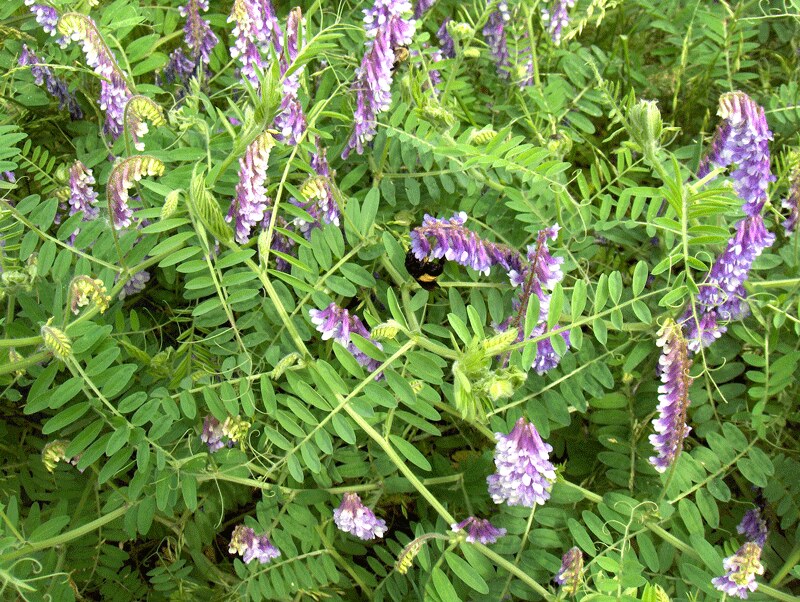
Buckwheat. Buckwheat is in theory an excellent flower for bees, because it is grown as a commercial food crop on a large scale. Buckwheat honey has a wonderful smell and flavour, and is highly valued. There is, however, a problem. Old varieties of buckwheat were great sources of nectar. Unfortunately, many modern varieties produce much less nectar, and some have stopped being attractive to bees.
Jerusalem artichoke. An excellent vegetable grown for its edible roots. Flowers beautifully in August-September. Important late-season food source for pollinators.
40 kg/ha
Gooseberry. Flowers very early in spring when few flowers are available.
Silverweed (Argentina anserina). A very common perennial plant. Grows on moist soil, in full sun or partial shade. Flowers for a long time from June to September.
40-50 kg/ha
Sunflower. A spectacular flower for a garden and a favourite with children. Flowers for about a month in July and August.
Oilseed rape (Brassica napus subsp. napus). Flowers for 40-50 days in April-May. Honey made by bees from oilseed rape nectar quickly crystalizes and is therefore unsuitable for overwintering.
50 kg/ha
Meadow crane’s-bill (Geranium pratense) and Wood crane’s-bill (Geranium sylvaticum). Crane’s-bills grow in meadows and woods. They prefer moist soil, but are very undemanding. They flower for a long time in the second half of the summer.
Meadow crane’s-bill, with large blue flowers, is particularly attractive and there are many decorative cultivars. I can testify from experience that wild meadow crane’s-bill is a wonderful flower to grow in the garden. It is immune to pests and diseases and looks beautiful through the entire season, even before flowering, due to its graceful lacy leaves. It flowers endlessly, and is not invasive and very well behaved.
60-70 kg/ha
White clover (Trifolium repens). White clover is not easily crushed and can grow and flower on lawns and in fields were animals graze. Flowers for a long time in the summer.
Lady’s thumb (Persicaria maculosa). An annual plant in the buckwheat family. An attractive-looking weed that grows on disturbed soil and cultivated fields. Prefers moist soil.
Jakob’s ladder (Polemonium caeruleum). Flowers in June. Very attractive and easy to grow, and there are many decorative cultivars. Not susceptible to any serious pests or diseases. A wonderful flower for bees.
Melancholy thistle (Cirsium heterophyllum). Grows in meadows, flowers in July and August.
Musk thistle (Cardus nutans). Grows on pastures and disturbed soil, such as fields and building sides. Can be invasive and a weed, but a great flower for pollinators.
40-100 kg/ha
White mustard (Sinapis alba). Undemanding, can cope with some drought and light frosts in early spring. Makes an excellent green manure that suppresses fungal diseases, such as potato wilt. Honey made from white mustard is pale yellow and crystalizes quickly.
60-100 kg/ha
Lungwort (species of Pulmonaria). Flowers from the end of April, for 25–30 days. A highly important food source for pollinators emerging from hibernation. Exceptionally beautiful and there are many decorative cultivars.
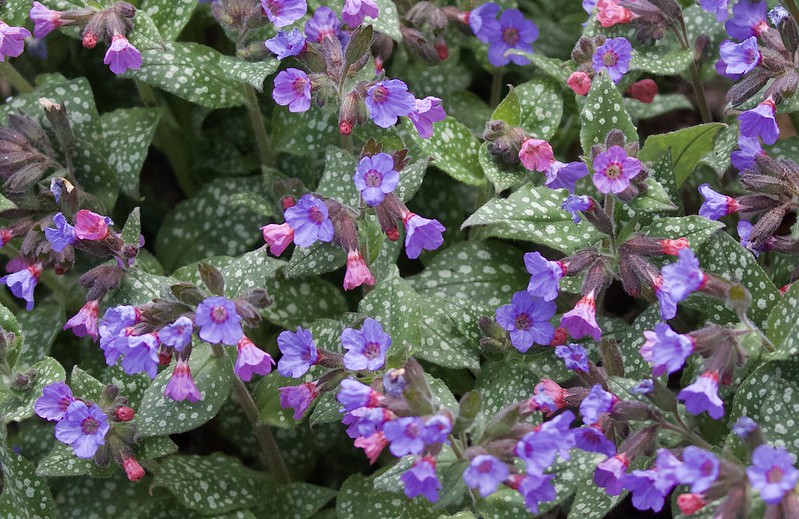
100 kg/ha
Comfrey (Symphytum officinale). Common and very undemanding. Beautiful and makes a great decorative plant, if space allows. Important medicinal plant. Useful in the garden as one of the best plants to use to make an organic fertilizer.
Burdock (Arctum tomentosum). A beautiful ‘statement’ plant, if space allows. Very important in traditional medicine. Grown commercially for its roots, used as an excellent vegetable and in cosmetics. Burdock honey has a wonderful taste, does not crystalize for several years (!), and is good for overwintering bees.
Dandelion (Taraxacum officinale). An excellent early source of nectar and pollen. Beautiful and uplifting and a great flower for bees. Has numerous medicinal and culinary uses.
Chicory (Cichorium intybus). A great flower for the garden, if space allows. Beautiful and abundant sky-blue flowers in the second half of the summer, produced for 40-45 days. Constantly visited by bees. Has many culinary uses.
Heather (Calluna vulgaris). Flowers for a very long time, from July to September. A valuable source of nectar for pollinators late in the season when few flowers are available. Can grow on poor, sandy, stony and acidic soils, on the sea coast and on mountain sides.
Speedwell (Veronica officinalis). Beautiful and undemanding, spreads easily. Great for a lawn in the sun or in partial shade.
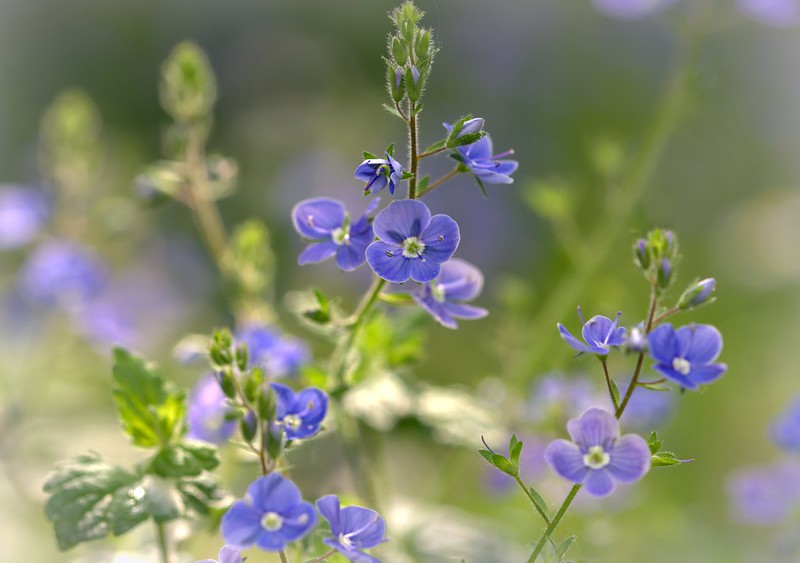
Oregano. Beautiful and very easy to grow, has many culinary uses. Flowers for a long time, July to September. Honey collected by bees from oregano remains liquid for a long time and is good for overwintering bees.
120 kg/ha
Pink clover (Trifolium hybridum). Not easily crushed, can grow and flower on lawns and fields where animals graze. Flowers for a long time in the summer. Grows well on acidic soils.
130 kg/ha
Coneflower (Echinacea purpurea). Flowers in July-September. Exceptionally beautiful and there are many decorative cultivars. Important food source for pollinators late in the season. Valuable medicinal plant.
100-150 kg/ha
Raspberry. Flowers in the summer, in June-August, depending on the variety. An excellent source of nectar, little affected by rainy weather. Very easy to grow, one of the best fruit plants for a garden.
Angelica (species of Angelica). Grows wild and is cultivated for medical and culinary use. Flowers for three weeks in June-July. An excellent ‘statement’ biannual plant for a garden.
150-200 kg/ha
Lemon balm (Melissa officinalis). Flowers for a long time, June-September. Has important uses in beekeeping. An excellent food source for bumble bees and butterflies.
200 kg/ha
Pussy willow and other willows (Salix caprea and other species of Salix). All willows are excellent for pollinators. Male flowers produce a large amount of pollen and some nectar. Much more modest-looking female flowers produce a lot of nectar.
Willows tend to attract masses of bees, bumble bees and other insects, particularly those that, like pussy willow, flower when other trees are still bare. This is an important time for pollinators emerging from hibernation and needing food.
Maple (species of Acer). Beautiful tree that flowers in May-June, depending on an area. A large tree can produce an abundance of nectar.
Tree mallow (Lavatera thuringiaca). A fantastic small bush for a garden. Produces masses of very attractive pink and white flowers through much of the summer. There are numerous decorative cultivars. All species of mallow, wild and garden varieties, are excellent sources of nectar and some of the best flowers for bees and other pollinators.
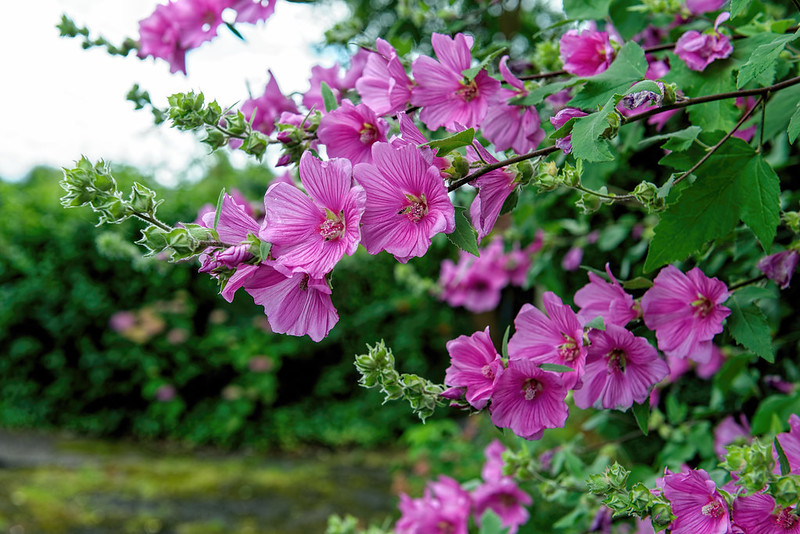
Thyme (Thymus vulgaris and other varieties). A wonderful plant for the garden. Very beautiful and has many medicinal and culinary uses. Does not mind poor soil, heat and dryness.
Lavender (species of Lavandula). Flowers abundantly in July-August. Easy to grow. A very beautiful plant for the garden and there are many decorative varieties. Honey from lavender remains liquid for a long time and is good for overwintering bees.
240 kg/ha
Red clover (Trifolium pratense). Flowers almost the entire summer. More attractive to butterflies and bumble bees than to honeybees. The tongue of honeybees is not long enough to easily reach nectar in clover’s long tubular flowers. Enriches soil with nitrogen, often grown as green manure.
100-350 kg/ha
Mint (species of Mentha). Has many medicinal and culinary uses. Very easy to grow, though can be invasive. Flowers prolifically and for a long time in July-September. An excellent plant for the garden and one of the best flowers for bees.
130-400 kg/ha
Sage (species of Salvia). There are numerous species of sage, including many decorative varieties and hybrids. Flowers in May-June. A very beautiful plant for the garden, loved by bees, bumblebees, butterflies and other pollinators.
280 kg/ha
Knapweed (Centaurea jacea). Grows in meadows in full sun. A very beautiful plant for the garden and there are decorative cultivars. Flowers for a long time from June to September. An important food source for pollinators late in the season.
200-300 kg/ha
Borage (Borago officinalis). Beautiful bright-blue flowers, produced 35-40 days after sowing. Flowering continues for a long time, until frosts. Young leaves have the smell and taste resembling cucumber and are excellent in salads. Prefers rich soil. Self-seeds easily and once planted is likely to persist in the garden.
150-300 and up to 500 in particularly good conditions
Phacelia (Phacelia tanacetifolia). Flowering starts 40-45 days after sowing and continues for 1.5 months. One of the most valuable features of phacelia is that its nectar production does not slow down in bad weather. It is immune to both high humidity and dryness. A drop in the production of nectar in such conditions is normal for a great majority of flowers.
Phacelia improves soil and is one of the most important flowers for bees. Honey that they make from its nectar does not crystallize for a long time. It is therefore good for overwintering bees.
300 kg/ha
Hyssop (Hyssopus officinalis). A very attractive plant for the garden. Used as spice.
Creeping thistle (Cirsium arvense). Flowers prolifically. A very common and highly successful, difficult to eliminate, weed. But in all sincerity it deserves to be cultivated by beekeepers!
350 kg/ha
Cornflower (Centaurea cyanus). A weed, grows only on disturbed soils, and therefore on cultivated fields. Often used as a decorative annual. Great as a cut flower and loved by florists. Very easy to grow from seed. An excellent flower for bees and the garden.
Purple loosestrife (Lythrum salicaria). Flowers for a long time, June to September. Very attractive, with many decorative cultivars. Requires wet soil, often grows on the banks of rivers, lakes and ponds.
400 kg/ha
Catmint (species of Nepeta). Exceptionally beautiful and easy to grow, and there are many decorative cultivars. Very attractive to pollinators. Flowers for a long time in May-July.
140-600 kg/ha
Yellow clover (Melilotus officinalis). Grows wild, often on disturbed soil, but is also cultivated. Used as green manure as it enriches soil with nitrogen. Flowers for a long time in July and early August. Honey collected by bees from yellow clover has an excellent taste, does not chrystallize for a long time, and is one of the best for overwintering bees.
In the wild yellow clover produces around 140-300 kg/ha of nectar. When cultivated on fertile soils it can produce 300-600 kg/ha.
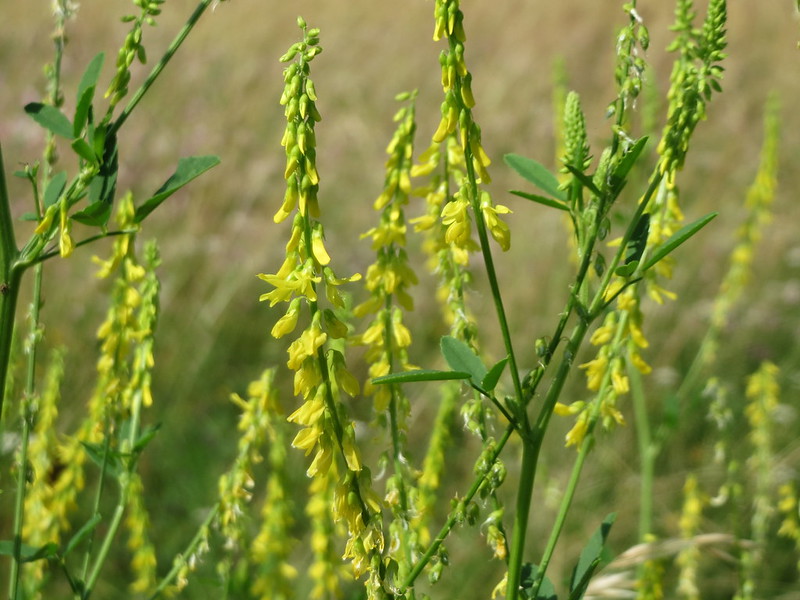
550-800 kg/ha
White acacia (Robinia pseudoacacia). A tree up to 12 m high. Flowers in May-June, producing masses of nectar.
Up to 800 kg/ha
Lime tree (Tilia cordata). Flowers in June and produces an abundance of nectar if the conditions are right. Somewhat unpredictable. There are years when lime trees flower, but make little nectar and are largely ignored by bees. This happens if the weather is cold a month before flowering. If this this occurs, a lime tree will produce little nectar, even if the weather is fine at the time of flowering.
Strong rains during flowering can also wash out nectar. Observations suggest that lime trees do their best and produce a very large quantity of nectar once every 5 years.
Rosebay willowherb (Chamaenerion angustifolium). An excellent source of nectar, if the conditions are right. Rosebay willowherb requires full sun — in partial shade its flowers become small and pale, and it produces less nectar, though it is still attractive to bees.
It also requires soil rich in potassium. It naturally grows in clearings in woods that occur as a result of fires. It therefore responds very well to ash from wood burning, a fertilizer rich in potassium.
300 kg/ha and up to 1300 kg/ha
Viper’s bugloss (Echium vulgare). Planted specially for bees, often mixed with phacelia. Normally produces 300 kg/ha, but in some years, when conditions are particularly good, up to 1300 kg/ha.
Frequently grown as an ornamental plant, and there are many decorative cultivars. Totally immune to pests and diseases. Annual echium is very adaptable and can be easily grown from seed in open ground as well as in pots, as I know from experience. It tolerates dryness, and grows and flowers very well, even in a small pot. It looks stunningly beautiful and is one of the most valuable flowers for bees.
1000 kg/ha
Globe-thistle (Echinops sphaerocephalus). Very undemanding and easy to grow. Stunningly beautiful and there are many decorative cultivars. Flowers for a long time in the second half of the summer. An important medicinal plant and one of the best flowers for bees, butterflies and other pollinators.
Nectar and honey
Nectar has a complex chemical composition and its properties affect honey made from it by bees. If nectar is rich in glucose, honey, where it dominates, will quickly crystallize. If nectar is rich in fructose, honey will remain liquid for a long time.
The fact that honey crystallizes does not affect its quality, nutritional or medicinal properties. Whether one likes liquid or crystallized honey is a matter of personal preference.
Honey that easily crystallizes, however, is believed by bee-keepers to be unsuitable for overwintering bees.
Nectar of plants from the cabbage family (Cruciferous), including oilseed rape, radishes and mustard is rich in glucose. It tends to be pale yellow in colour and crystallizes very easily, sometimes just days after being collected. Oilseed rape honey does not store well.
Nectar of plants of the bean family, including white, pink and red clovers, yellow clover, lucerne, beans and peas, is rich is fructose. It remains liquid and transparent much longer. It is good for overwintering bees.
Nectar rich in fructose is also produced by plants from the Labiatae family (mint, oregano, hyssop, thyme, lavender and other) and from the borage (Boraginaceae) family (comfrey, viper’s bugloss and other).
Image credits: hairy vetch by Homer Edward Price; lungwort by Under the same moon…; speedwell (Veronica officinalis) by Alison day; lavatera by Iain Middleton-Duff; yellow clover (Melilotus officinalis) by Andreas Rockstein
Posts related to ‘What are the Best Nectar-Producing Flowers for Bees?’
What is Nectar: Basics for a Bee-Lover
What is Pollen: Basics for a Bee-Lover
Best Wild Flowers for Bees and Butterflies
How to Make your Vegetable Garden Bee Friendly
10 Ideas for a Natural Organic Garden
Pin ‘What are the Best Nectar-Producing Flowers for Bees?” for later
